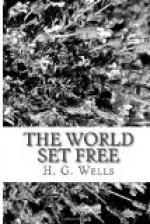It was in 1953 that the first Holsten-Roberts engine brought induced radio-activity into the sphere of industrial production, and its first general use was to replace the steam-engine in electrical generating stations. Hard upon the appearance of this came the Dass-Tata engine—the invention of two among the brilliant galaxy of Bengali inventors the modernisation of Indian thought was producing at this time—which was used chiefly for automobiles, aeroplanes, waterplanes, and such-like, mobile purposes. The American Kemp engine, differing widely in principle but equally practicable, and the Krupp-Erlanger came hard upon the heels of this, and by the autumn of 1954 a gigantic replacement of industrial methods and machinery was in progress all about the habitable globe. Small wonder was this when the cost, even of these earliest and clumsiest of atomic engines, is compared with that of the power they superseded. Allowing for lubrication the Dass-Tata engine, once it was started cost a penny to run thirty-seven miles, and added only nine and quarter pounds to the weight of the carriage it drove. It made the heavy alcohol-driven automobile of the time ridiculous in appearance as well as preposterously costly. For many years the price of coal and every form of liquid fuel had been clambering to levels that made even the revival of the draft horse seem a practicable possibility, and now with the abrupt relaxation of this stringency, the change in appearance of the traffic upon the world’s roads was instantaneous. In three years the frightful armoured monsters that had hooted and smoked and thundered about the world for four awful decades were swept away to the dealers in old metal, and the highways thronged with light and clean and shimmering shapes of silvered steel. At the same time a new impetus was given to aviation by the relatively enormous power for weight of the atomic engine, it was at last possible to add Redmayne’s ingenious helicopter ascent and descent engine to the vertical propeller that had hitherto been the sole driving force of the aeroplane without overweighting the machine, and men found themselves possessed of an instrument of flight that could hover or ascend or descend vertically and gently as well as rush wildly through the air. The last dread of flying vanished. As the journalists of the time phrased it, this was the epoch of the Leap into the Air. The new atomic aeroplane became indeed a mania; every one of means was frantic to possess a thing so controllable, so secure and so free from the dust and danger of the road, and in France alone in the year 1943 thirty thousand of these new aeroplanes were manufactured and licensed, and soared humming softly into the sky.




